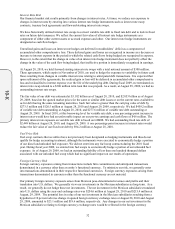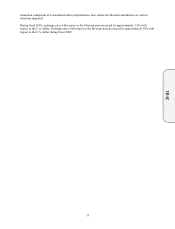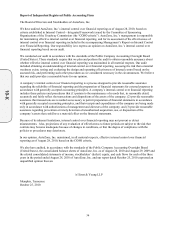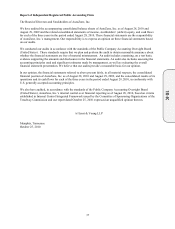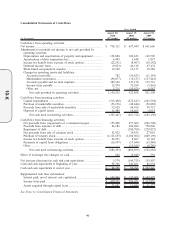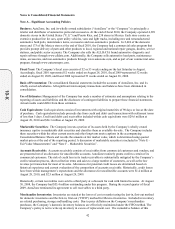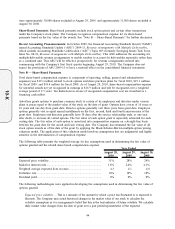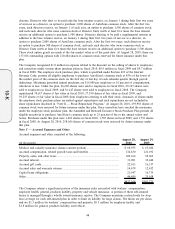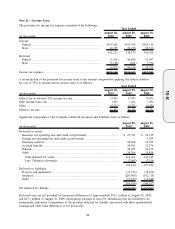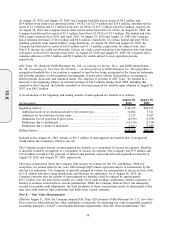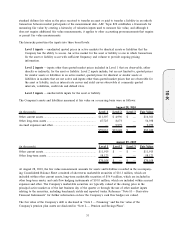AutoZone 2010 Annual Report Download - page 132
Download and view the complete annual report
Please find page 132 of the 2010 AutoZone annual report below. You can navigate through the pages in the report by either clicking on the pages listed below, or by using the keyword search tool below to find specific information within the annual report.
Notes to Consolidated Financial Statements
Note A – Significant Accounting Policies
Business: AutoZone, Inc. and its wholly owned subsidiaries (“AutoZone” or the “Company”) is principally a
retailer and distributor of automotive parts and accessories. At the end of fiscal 2010, the Company operated 4,389
domestic stores in the United States (“U.S.”) and Puerto Rico, and 238 stores in Mexico. Each store carries an
extensive product line for cars, sport utility vehicles, vans and light trucks, including new and remanufactured
automotive hard parts, maintenance items, accessories and non-automotive products. In 2,424 of the domestic
stores and 173 of the Mexico stores at the end of fiscal 2010, the Company had a commercial sales program that
provides prompt delivery of parts and other products to local, regional and national repair garages, dealers, service
stations, and public sector accounts. The Company also sells the ALLDATA brand automotive diagnostic and
repair software through www.alldata.com. Additionally, the Company sells automotive hard parts, maintenance
items, accessories, and non-automotive products through www.autozone.com, and as part of our commercial sales
program, through www.autozonepro.com.
Fiscal Year: The Company’s fiscal year consists of 52 or 53 weeks ending on the last Saturday in August.
Accordingly, fiscal 2010 represented 52 weeks ended on August 28, 2010, fiscal 2009 represented 52 weeks
ended on August 29, 2009, and fiscal 2008 represented 53 weeks ended on August 30, 2008.
Basis of Presentation: The consolidated financial statements include the accounts of AutoZone, Inc. and its
wholly owned subsidiaries. All significant intercompany transactions and balances have been eliminated in
consolidation.
Use of Estimates: Management of the Company has made a number of estimates and assumptions relating to the
reporting of assets and liabilities and the disclosure of contingent liabilities to prepare these financial statements.
Actual results could differ from those estimates.
Cash Equivalents: Cash equivalents consist of investments with original maturities of 90 days or less at the date
of purchase. Cash equivalents include proceeds due from credit and debit card transactions with settlement terms
of less than 5 days. Credit and debit card receivables included within cash equivalents were $29.6 million at
August 28, 2010 and $24.3 million at August 29, 2009.
Marketable Securities: The Company invests a portion of its assets held by the Company’s wholly owned
insurance captive in marketable debt securities and classifies them as available-for-sale. The Company includes
these securities within the other current assets and other long-term assets captions in the accompanying
Consolidated Balance Sheets and records the amounts at fair market value, which is determined using quoted
market prices at the end of the reporting period. A discussion of marketable securities is included in “Note E –
Fair Value Measurements” and “Note F – Marketable Securities”.
Accounts Receivable: Accounts receivable consists of receivables from commercial customers and vendors, and
are presented net of an allowance for uncollectible accounts. AutoZone routinely grants credit to certain of its
commercial customers. The risk of credit loss in its trade receivables is substantially mitigated by the Company’s
credit evaluation process, short collection terms and sales to a large number of customers, as well as the low
revenue per transaction for most of its sales. Allowances for potential credit losses are determined based on
historical experience and current evaluation of the composition of accounts receivable. Historically, credit losses
have been within management’s expectations and the allowances for uncollectible accounts were $1.4 million at
August 28, 2010, and $2.5 million at August 29, 2009.
Historically, certain receivables were sold to a third party at a discount for cash with limited recourse. At August
30, 2008, the Company had $55.4 million outstanding under this program. During the second quarter of fiscal
2009, AutoZone terminated its agreement to sell receivables to a third party.
Merchandise Inventories: Inventories are stated at the lower of cost or market using the last-in, first-out method
for domestic inventories and the first-in, first out (“FIFO”) method for Mexico inventories. Included in inventory
are related purchasing, storage and handling costs. Due to price deflation on the Company’s merchandise
purchases, the Company’s domestic inventory balances are effectively maintained under the FIFO method. The
Company’s policy is not to write up inventory in excess of replacement cost. The cumulative balance of this
42
10-K


